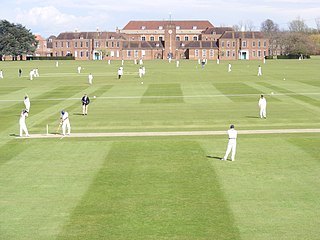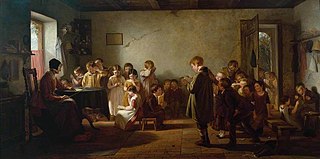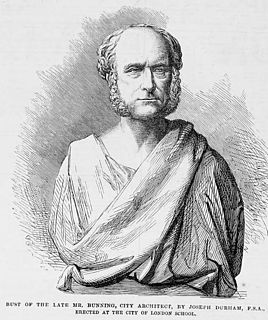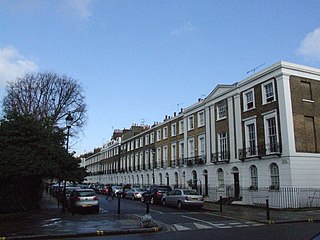
A primary school, junior school, elementary school or grade school is a school for primary education of children who are five to eleven years of age. In South Africa, primary school starts from Grade R till Grade 7. It typically comes after preschool and before secondary school.

Islington is a district in Greater London, England, and part of the London Borough of Islington. It is a mainly residential district of Inner London, extending from Islington's High Street to Highbury Fields, encompassing the area around the busy High Street, Upper Street, Essex Road, and Southgate Road to the east.

Education in the Netherlands is characterized by division: education is oriented toward the needs and background of the pupil. Education is divided over schools for different age groups, some of which are divided in streams for different educational levels. Schools are furthermore divided in public, special (religious), and general-special (neutral) schools, although there are also a few private schools. The Dutch grading scale runs from 1 to 10 (outstanding).

In the United Kingdom, independent schools are fee-charging schools, typically governed by an elected board of governors and independent of many of the regulations and conditions that apply to state-funded schools. For example, pupils do not have to follow the National Curriculum. Historically, the term 'private school' referred to a school in private ownership, in contrast to an endowed school subject to a trust or of charitable status. Many of the older and more exclusive independent schools catering for the 13–18 age range in England and Wales are known as public schools, seven of which were the subject of the Public Schools Act 1868. The term 'public school' derived from the fact that they were then open to pupils regardless of where they lived or their religion. Prep (preparatory) schools educate younger children up to the age of 13 to 'prepare' them for entry to the public schools and other independent schools. Some former grammar schools converted to an independent fee-charging model following the 1965 Circular 10/65, which marked the end of their state funding; others converted into comprehensive schools.

Downham Market, sometimes simply referred to as Downham, is a market town and civil parish in Norfolk, England. It lies on the edge of the Fens, on the River Great Ouse, approximately 11 miles south of King's Lynn, 39 miles west of Norwich and 30 miles north of Cambridge.
The Anna Scher Theatre is an independent and co-educational performing arts school based in Islington, Greater London. It was founded in 1968 by Anna Scher. It is considered among the first schools of its kind geared towards working class students.

Monkton Combe School is a public school, located in the village of Monkton Combe near Bath in Somerset, England. It is a member of the Rugby Group of independent boarding schools in the United Kingdom.

The Girls' Day School Trust (GDST) is a group of 25 independent schools – 23 schools and two academies – in England and Wales, catering for girls aged 3 to 18. It is the largest group of independent schools in the UK, and educates 20,000 girls each year. It was formed in 1872 to provide affordable day-school (non-boarding) education for girls as The Girls' Public Day School Company (1872–1905), then The Girls' Public Day School Trust (1906–1998).

Dame schools were small, privately run schools for young children that emerged in the British Isles and its colonies during the early modern period. These schools were taught by a “school dame,” a local woman who would educate children for a small fee. Dame schools were extremely localized, and could typically be found at the town or parish level.
Twyford School is a co-educational, independent, preparatory boarding and day school, located in the village of Twyford, Hampshire, England.

Finborough School is a co-educational independent school. It is situated in and around Finborough Hall, in the village of Great Finborough, near Stowmarket, Suffolk, England.

Griffith Davies was a noted actuary.
Langley School is an HMC independent co educational day, weekly, flexi and full boarding school situated near the market town of Loddon in South Norfolk, England. The current headmaster is Jon Perriss, who has been in post since 2019, and the school is a member of the Society of Heads. Termly fees are currently £5,087 for day pupils, £8,624 for weekly boarders and £10,337 for full boarders.
William Michael Duane was an Irish born, British teacher known for his progressive educational views, his belief in inclusivity and a multi-racial approach, his encouragement of informal relationships between staff and pupils and his opposition to corporal punishment. He was also the head of the controversial short-lived Risinghill School in Islington.

St. Mary's Town and Country School was an independent, non-denominational, co-educational progressive day and boarding school, founded in Belsize Park, London in 1937. It closed at the end of 1982.

Chinthurst School is an independent co-educational nursery, pre-preparatory and preparatory school in semi-rural surroundings in the village of Tadworth, Surrey, England, 15 miles south of the centre of London. As a member of the RGS Group, the school is associated with Reigate Grammar School and Reigate St Mary's School. Its pupils' ages range from two to eleven years.
Risinghill School was a progressive co-educational secondary school that opened in Islington, north London, on 3 May 1960 and closed four and a half years later. A book chronicling its demise made publishing history in 1968 by becoming the UK's first non-fiction best-seller.
Alexander Kennedy Isbister was born at Cumberland House in what is now Saskatchewan. He was an HBC employee in his early career and later was a lawyer and an educational writer and author of many school books.

James Bunstone Bunning was an English architect. He held the post of architect to the City of London from 1843 until his death, and is probably best remembered for his design for the Coal Exchange.

Gibson Square is a garden square in the Barnsbury district of Islington, North London. It is bounded by Regency and Victorian terraced houses, most of which are listed buildings. The central public gardens contain flower beds and mature trees, and an unusual building resembling a classical temple.














